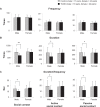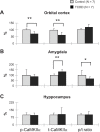Influence of Maternal Exposure to 2,3,7,8-Tetrachlorodibenzo-p-dioxin on Socioemotional Behaviors in Offspring Rats
- PMID: 23493046
- PMCID: PMC3588853
- DOI: 10.4137/EHI.S10346
Influence of Maternal Exposure to 2,3,7,8-Tetrachlorodibenzo-p-dioxin on Socioemotional Behaviors in Offspring Rats
Abstract
Effects of dioxins on cognitive functions were reported in previous studies conducted in humans and animals. In the present study, we investigated the influence of dioxin exposure during pregnancy on social interaction and on the activity of offspring, which are related to neurodevelopmental disturbances. In addition, we analyzed neurochemical alterations of the limbic system of rat brains to suggest one mechanism of dioxin effects on brain function. We believe that this manuscript is suitable for publication in "Environmental Health Insights" because it provides an interesting topic for a wide global audience. To clarify the relationships between maternal dioxin exposure and socioemotional functions of rat offspring, dams were given TCDD (1.0 μg/kg) on gestational day 15. Social interactions and forced swimming time were compared between TCDD-exposed and control offspring in each gender. Frequency and duration of locomotion were higher, and durations per one behavior of proximity and social contact were significantly lower in the exposed males, while only the duration of proximity was lower in the exposed females. Forced swimming time on the first day was significantly longer in the exposed males. In the limbic system of the rat brain, the levels and/or activity of CaMKIIα were decreased in males and were increased in females in the exposed offspring. These results suggest that prenatal TCDD exposure induces hyperactivity and socioemotional deficits, particularly in the male offspring due to alterations in CaMKIIα activity in the limbic system of the brain.
Keywords: CaMKIIα; TCDD; maternal exposure; offspring rats; socio-emotional behavior.
Figures







References
-
- Rogan WJ, Gladen BC, Hung KL, et al. Congenital poisoning by polychlorinated biphenyls and their contaminations in Taiwan. Science. 1988;241(4863):334–6. - PubMed
-
- Chen YJ, Guo YL, Hsu CC. Cognitive development of children prenatally exposed to polychlorinated biphenyls (Yu-Cheng children) and their siblings. J Formos Med Assoc. 1992;91(7):704–7. - PubMed
-
- Koopman-Esseboom C, Weisglas-Kuperus N, deRidder MA, VanderPaauw CG, Tuinstra LG, Sauer PJ. Effects of polychlorinated biphenyl/dioxin exposure and feeding type on infants’ mental and psychomotor development. Pediatrics. 1996;97(5):700–6. - PubMed
-
- Pham TT, Nishijo M, Nakagawa H, et al. Associations of perinatal dioxin exposure on neurodevelopment of Vietnamese infants. Am J Epidemiol. 2013. (in press).
LinkOut - more resources
Full Text Sources
Other Literature Sources

